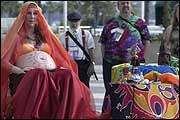Counterculture church?
How American culture transforms—and is sometimes transformed by—liberal religion.
Two scholars have published engaging new histories that set our changes in the context of larger religious trends. Leigh Eric Schmidt’s Restless Souls tracks the rise of American “spirituality” from its Unitarian roots in the Transcendentalist movement of the 1840s. He argues that spirituality—personal, nondogmatic, religious seeking—is the heart of liberal religion, a broader and more deeply rooted American phenomenon than its orthodox Christian critics admit. Mark Oppenheimer’s Knocking on Heaven’s Door offers a provocative study of organized religion’s responses to the counterculture of the 1960s and ’70s. He tells the story of the UUA’s embrace of gay rights in the early 1970s alongside stories about the ordination of women in the Episcopal Church, the rise of Jewish worship communities outside of synagogues, the introduction of the Roman Catholic “folk mass,” and the failure of an antiwar movement within the Southern Baptist Convention. Both books are excellent; Oppenheimer’s is indispensable.
Schmidt, a Princeton historian, shows how Americans came to distinguish spirituality from religion. Although the book doesn’t quite trace the story all the way from “Emerson to Oprah,” as the dust jacket promises, Unitarians are central to it. Schmidt extends the history of their influence beyond the nineteenth century, showing how Transcendentalists’ ideas influenced scholars and new religious movements into the first half of the twentieth century.
Our UU emphasis on the individual search for religious meaning is not unique. We share a religious outlook with many other Americans: “call it transcendental cosmopolitanism, Inner-Light liberalism, Whitman’s sublime religious democracy, or the Spiritual Left,” Schmidt suggests. Notably, he wants to find in the Spiritual Left a political counterweight to today’s militant Christian Right. True, many proponents of nondogmatic spirituality were politically progressive, but Schmidt doesn’t show that a commitment to personal religious experience yields anything like a sustained political or cultural movement. The Spiritual Left, as he depicts it, is extra-ecclesial; its institutions are retreat centers, college classrooms, and bookstores, never congregations or denominations or regional cultures. But the Christian Right is dominated by all three of these. Religious liberalism’s influence on the culture is diffuse and unfocused, and therefore politically impotent; the Christian Right is anything but.
Oppenheimer doesn’t track liberal religious ideas as they spread out across the culture. Instead, he looks at how the sixties counterculture was reflected in mainstream religious movements. Few people, he notes, really dropped out of their churches or synagogues to join new religious movements. Even at Berkeley, a study of undergraduates from 1970 to 1974 showed that only 4 percent of Jewish students and 3 percent of Protestant or Catholic students had “Eastern/ mystical” beliefs by their junior year. Yet dramatic changes did take place: “What happened from 1968 to 1975 was less a political shift than a visible assertion of countercultural aesthetics,” he argues—like guitars at mass.
His chapter on the UUA’s embrace of homosexuality in the early 1970s is thorough and informative. But his suggestion that Unitarian Universalism has made the counterculture normative is misleading. Drawing on the moral authority of the civil rights movement but styled after the black power movement, he says, counterculture always prevailed in the UUA of the ’70s. It’s still true that UU churches are almost uniquely receptive to offbeat groups and unconventional opinions, but most congregations are also closely tied to liberal (not radical) local institutions and draw many members from the professional middle class. We have a foot solidly planted in mainstream culture. And the sixties have grown less compelling. Renewed interest in questions of UU identity and tradition suggest that many UUs want roots in something other than secular society or its bygone counterculture.
Schmidt shows that liberal religious ideas and values have spread far beyond our denominational borders; some are now practically mainstream. Oppenheimer adds that the only enduring form that a counterculture can take is religious: a self-sustaining alternate form of life. Doug Muder recently proposed a six-word mission statement for a UU church: “Becoming the people the world needs.” We have religious resources, cultural resources, and even countercultural resources to help us.








